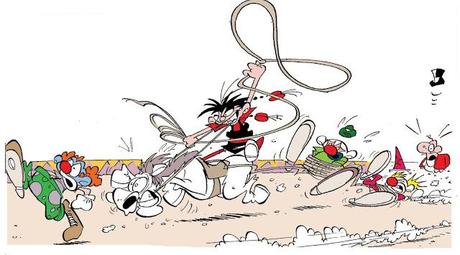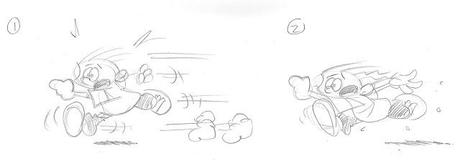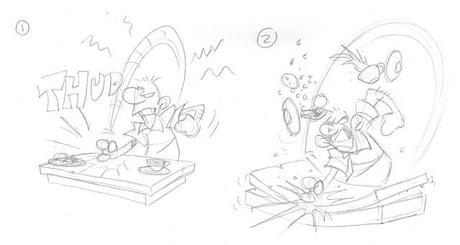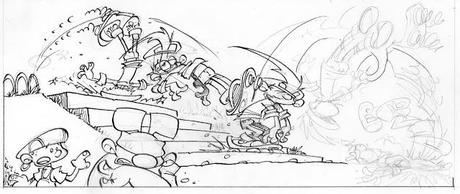 Over the years it has been said by many people, including my peers, that my style is either European or that it show a fluidity of movement.
Over the years it has been said by many people, including my peers, that my style is either European or that it show a fluidity of movement.I will gladly admit to the European influence; I grew up devouring Asterix the Gaul and Lucky Luke, both of which were, and still are, giants of the Franco-Belgian Bande Dessinee movement.
I'd grown bored and uninspired by most of the home-grown material in the UK; it looked tired and lacked the pizazz of all that was coming over from Europe at the time. The colour, the pace, the well rounded characters, the great story telling and the action.
And it is this last noun that most people use to describe my work: The action, and it is this that I'm going to devote my latest post to.
Now I know that cartoons are supposed to abound with action, but the sad truth is that generally speaking they aren't. This can be put down to space restrictions--- in the case of the daily newspaper strip---or a basic lack of the understanding of movement, which is sadly the usual case.
When I first started copying Uderzo (the artist on Asterix the Gaul), I was inadvertently infusing into my work a lot of action. I was, admittedly, unaware of what I was doing, but as luck would have it, my formative years in the field of learning the craft of cartooning was spent at the metaphorical feet of the worlds greatest exponent of fluid cartoon action.
So today I am going to pass a little of that knowledge on to anyone who's interested.
Below I've given you two approaches to the same situation. In the first I have emulated what I see so much of in comics or cartoon strips: the over use of action lines. Now I've nothing against action lines but too many pictures are filled with these confusing little buggers; the are, to me, the 'apostrophe argument' of the cartoon world.
 Action lines should only be used to show extreme action. Action like a rocket coming at you from the horizon, or a cannonball as it courses through the sky; in other words: an image that needs to define great speed and not, as is the usual case, to show someone running to catch a bus or train. What I do in these situations--- and I've illustrated my point on the right hand picture--- is to use the angle of the shadow of the character to denote movement by setting it a little behind him; this gives the impression of forward motion. Also, another good trick is to show flecks of dirt in the characters wake; this, once again, gives the impression that he has kicked up dust from the pounding of his feet. It's exactly the same effect but a lot less cluttered and in a time where space is of a premium to commissioning editors, and cartoons are shrinking all the time, it helps the cartoon look cleaner and less confusing for the reader, and it helps it look fluid.
Action lines should only be used to show extreme action. Action like a rocket coming at you from the horizon, or a cannonball as it courses through the sky; in other words: an image that needs to define great speed and not, as is the usual case, to show someone running to catch a bus or train. What I do in these situations--- and I've illustrated my point on the right hand picture--- is to use the angle of the shadow of the character to denote movement by setting it a little behind him; this gives the impression of forward motion. Also, another good trick is to show flecks of dirt in the characters wake; this, once again, gives the impression that he has kicked up dust from the pounding of his feet. It's exactly the same effect but a lot less cluttered and in a time where space is of a premium to commissioning editors, and cartoons are shrinking all the time, it helps the cartoon look cleaner and less confusing for the reader, and it helps it look fluid.Think of an image of someone hitting a table and you will probably visualise a fist slamming down with zig-zaggidy marks around it to denote impact. That's fine, but if you think again and think about how the action impacts on everything around it you will realize that when the fist connects with the table---making all those zig-zag lines--- you could also visualise a cup and saucer, or a tea-pot or a plate of food spinning into the air with its contents rising above the plate, and have the table bending from the act of what's just happened to it. The character himself, how would he be looking? He's hitting the table. Is it an act of anger or violence? Show that action, show the anger, not only in his face but his body and posture. What direction was the blow coming from prior to the impact? Show it with lines, after all this is a furious speed moment.
The first illustration shows impact, the second one shows impact and action. There is, you see, a difference.
 This is only a basic tutorial and I could go on forever about how movement works in a cartoon, and I will come back to this most important of tools in the cartoonists box of tricks from time to time. But if you take one simple thing away with you today it should be this: When drawing action think about how that action impacts on the world around it. If your characters running down the street think: what time of the year is it? If its Autumn (or fall), show leaves being kicked up. Is it a wet day? Show puddles being splashed and dampen your characters hair down; maybe furrow the brow---just like you would while caught out in the rain. If its snowing, have your character bounding through the deep snow; no one can run through snow, you leap and bound. Remember, think about the action and your picture will show life and form and have a natural fluidity to it.
This is only a basic tutorial and I could go on forever about how movement works in a cartoon, and I will come back to this most important of tools in the cartoonists box of tricks from time to time. But if you take one simple thing away with you today it should be this: When drawing action think about how that action impacts on the world around it. If your characters running down the street think: what time of the year is it? If its Autumn (or fall), show leaves being kicked up. Is it a wet day? Show puddles being splashed and dampen your characters hair down; maybe furrow the brow---just like you would while caught out in the rain. If its snowing, have your character bounding through the deep snow; no one can run through snow, you leap and bound. Remember, think about the action and your picture will show life and form and have a natural fluidity to it.Okay, onto my next point. Lets say you've been asked to draw a character doing a sequence of actions. For example: going down the stairs like a slinky. The writer may have said do this over five or six panels. Ignore them. You can do it in one and make it look terrific.
This idea wasn't invented by me but it is a vastly under used trick in the field of sequential cartoon art.
Below I've laid out just such a situation: In this idea I had the wheels of the skate board turn into springs to aid the skater boy to leap objects. But in classic comic fashion, it goes wrong and the skateboard and its newly acquired springs, turn our hapless little chap into a human slinky. Now rather than show this over a series of pictures---like the writer would have me do---I animated it. I simply thought about how the character would move, which steps he would land on and where he would end up. All that was left for me to do was insert a hanging mid air illustration and the action is complete.
 (This picture was scanned in half completed so you can get a rare view of how much, or little, work goes into my layouts and finished pictures.)
(This picture was scanned in half completed so you can get a rare view of how much, or little, work goes into my layouts and finished pictures.)I hope you've enjoyed this little tutorial. Keep coming back and I will do more.
Next week I'll be showing you how I draw the main characters from my very popular weekly story, Brabbles & Boggitt which I publish every Friday here at Diary of a Cartoonist and Writer. I've received quite a few emails about this story and its characters and I've been asked how I make them look consistent through out, and more than a few of you have requested that I do a post on how to draw Brabbles & Boggitt. So next week I'll do just that in another tutorial.
...And don't forget to come back on Friday for the latest page of comic tom-foolery from the Brabbles & Boggitt tale.
See you all then.
If you like my blog and the things that I say and do, please tell your friends; mention me on Facebook, Twitter and any of the other fine social media networking sites you use. I would love to have my work reach a much larger audience and although I could no doubt eventually get there under my own steam, I'll get there a lot quicker with your help, so please, please spread the word.Thank you
